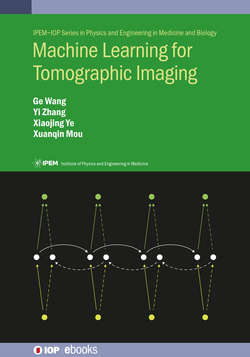Читать книгу Machine Learning for Tomographic Imaging - Professor Ge Wang - Страница 14
На сайте Литреса книга снята с продажи.
0.3 Analytic/iterative/deep learning algorithms for tomographic reconstruction
ОглавлениеTraditionally, there are two kinds of algorithms for tomographic reconstruction—analytic and iterative. When tomographic data are of high quality and sufficiently collected, the relationship from an underlying image to the tomographic measures can be expressed as a forward model, which can be mathematically and computationally inverted. The inverse transform will transform the data back to the underlying image, which is what image reconstruction means. When such an inverse transform is in a closed form (for example, an inverse Fourier transform), a reconstruction algorithm can be directly obtained, and implemented on a computer.
When tomographic data are compromised, incomplete, or the forward model is too complicated to be analytically inverted, an iterative algorithm can be used for image reconstruction. An iterative algorithm does not solve the problem in one shot. From an initial estimate of the underlying image, which can be as simple as an all zero or all one image or another form when specific prior knowledge is available, the algorithm refines an intermediate solution iteratively (the first one is the initially guessed image). The refinement is guided by two preferences. First, the discrepancy should be small between the measured data and the data computed according to the forward model based on an intermediate image. Second, the characteristics of a reconstructed image should look reasonable or consistent with our prior knowledge, such as non-negative pixel values and no severely oscillating features. These requirements are summarized into an overall objective function, and the reconstruction problem becomes an optimization task. In other words, the iterative algorithm is just for this optimization. In most cases of tomographic imaging, measured data are not enough to determine the underlying image uniquely, and prior knowledge is instrumental for satisfactory image reconstruction. The stronger the prior knowledge is, the better the reconstructed image quality will be. Various kinds of prior knowledge are in use for iterative reconstruction, including non-negativity, maximum entropy, roughness penalty, total variation minimization, low rank, dictionary, and low-dimensional manifold learning. Normally, an iterative algorithm is very time-consuming.
It is clear now that deep learning networks form the third category of image reconstruction algorithms. In contrast to the aforementioned kinds of prior knowledge, each of which can be formulated as one mathematical term in one or two lines, an unprecedented source of prior knowledge is big data. For example, millions of CT scans contain overwhelming information on underlying anatomical and pathological information, and a new scan should be very much correlated to or consistent with the existing scans. If these data can be utilized for image reconstruction, superior image quality is expected. Fortunately, deep neural networks can be trained with big data on a high-performance computing platform so that prior knowledge can be represented by the trained neural network that serves as a mapping from data to images. Because the prior knowledge used by the neural network is task-specific and yet comprehensive, in principle the network may produce better image quality than an iterative algorithm when it falls short of clinical satisfaction. Although training the network is still time-consuming, the trained network only involves forward operations and is computationally efficient.
The analytic, iterative, and deep learning algorithms for tomographic image reconstruction can be compared and contrasted (table 0.1). Briefly speaking, an analytic algorithm can be formulated in the following form, f(x,y)=Op(θ,t), where f represents an image in a 2D case without loss of generality, p denotes data as a function of projection viewing angle and detector position, and O is an analytic operation in the closed form, such as an inverse Fourier transform. An iterative algorithm, on the other hand, is expressed as f(k)(x,y)=Op(θ,t),f(k−1)(x,y), where the index k goes from 0, 1, 2, to a sufficiently large number K for the iterative process to converge. The image for k = 0 is the initial guess as the starting point of the iterative process. Different from either analytic or iterative algorithms, a deep learning based tomographic reconstruction algorithm is written as f(x,y)=OθN…Oθ1p(θ,t), where each operator corresponds to a layer of artificial neurons whose parameters θ1,…,θN need to be optimized in the training process with big data. Although a deep algorithm may still be slightly slower than an analytic algorithm, it is much faster than an iterative algorithm, since normally N ≪ K.
Table 0.1. Three types of tomographic image reconstruction algorithms in an over-simplified comparison (the penalization of image reconstruction and topology of network architecture can be complicated).
| Category | Form | Knowledge | Input | Quality | Speed |
|---|---|---|---|---|---|
| Analytic reconstruction | f=Op | Idealized model, without noise | High SNR, complete | High | High |
| Iterative reconstruction | f(k)=Op,f(k−1) | Physical model, image prior | Low in various ways | Decent | Low |
| Deep reconstruction | f=OθN…Oθ1p | Model, prior, big training data | Poor, incomplete | Superior, task-specific | High |
